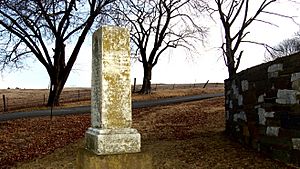Moravian mission at Shekomeko facts for kids
Quick facts for kids
Moravian mission at Shekomeko
|
|
|---|---|
|
Mission station
|
|
| Country | United States |
| State | New York |
| Founded | 1740 |
| Disbanded | 1746 |
| Founded by | Christian Henry Rauch |
The Moravian mission at Shekomeko was a special place founded in 1740. It was started by a man named Christian Henry Rauch. His goal was to share the Christian faith with the Mahican people. This mission was located in eastern New York.
Contents
Starting the Mission in New York
The Moravian Church began its first missionary work in North America in the late 1730s. This was near a place called Bethlehem, Pennsylvania. The Moravian Church itself was very old, started in the 1400s in Europe.
In 1740, a Moravian leader named August Gottlieb Spangenberg sent Christian Henry Rauch to New York City. Rauch's job was to preach and connect with native peoples. He arrived in New York on July 16, 1740. There, he met some Mahican leaders who were in the city to discuss land issues.
The Mahicans were a native tribe from the Algonquian family. They lived along the east side of the Hudson River. This area is now eastern Dutchess County, New York, and western Connecticut. Rauch found he could talk with the Mahicans in Dutch. They knew some Dutch from trading with Dutch settlers along the Hudson River.
Building the Mission at Shekomeko
Rauch showed the Mahican leaders that he was serious about teaching them. So, Mahican Chiefs Tschoop and Shabash invited him to their village in Dutchess County. The Mahicans already knew about Christian missionaries. They had met Congregationalists in nearby Stockbridge, Massachusetts.
Rauch arrived in Shekomeko in mid-August. He lived with the Mahicans and learned their language. At first, some people made fun of his efforts. But he kept going and started the Moravian mission there. Soon, the two Mahican chiefs, Tschoop and Shabash, became followers of the Moravian faith.
The next year, another missionary named Gottlieb Buttner joined Rauch. In February 1742, Rauch and Buttner traveled to Bethlehem, Pennsylvania. There, they became deacons, which are church leaders. Three Mahicans went with them and were baptized. Tschoop, who was lame, could not make the trip. The three Mahicans who were baptized were given Christian names: Abraham, Isaac, and Jacob.
After they returned to Shekomeko, Tschoop was baptized as Johannes on April 16, 1742. Sadly, Johannes died in Shekomeko in August 1746 from smallpox.
By the summer of 1742, Shekomeko became the first native Christian group in America. On October 1, 1742, missionary Gottlieb Buttner brought his wife to the mission. By the end of 1742, another missionary, Martin Mack, and his wife, Jeannette Rowe, joined the group. Rauch also visited Bethlehem and returned in early 1743 with his new wife. Two more missionaries, each with their wives, arrived soon after. The Shekomeko group had thirty-one Mahican Christians. In late January 1743, Martin Mack and his wife moved to Pachgotgoch, a Mahican village in Connecticut.
On March 13, 1743, the mission celebrated Holy Communion. This was an important step for the native Christian group. In July 1743, a Moravian chapel was built and dedicated at Shekomeko. By the end of 1743, sixty-three baptized Mahicans were part of the group. Two smaller mission outposts were also set up. One was in Kent, Connecticut, and the other was on the New York-Connecticut border.
Challenges and Difficulties
The Moravian mission's growing success started to worry the white settlers in the area. False stories were spread, and some scared settlers left their farms. People asked the authorities to step in. The settlers' dislike for the Moravians grew quickly.
The Moravian missionaries had exposed traders who were illegally selling alcohol to the native people. They also gave legal advice to help the Mahicans avoid being cheated. Some Mahicans even reported that a settler offered them rum if they would kill Brother Rauch.
The Moravian missionaries were often stopped, questioned, and fined. But they were always released. Governor George Clinton called the Moravians to explain their work. People claimed they were working with the Roman Catholic Jesuits, who were not allowed. The Moravians successfully proved they had no link to the Jesuits and were found innocent. However, they were told not to cause any more suspicion.
The settlers' anger towards the Moravians continued to grow. They wanted to shut down the Shekomeko mission. A new law was passed on September 21, 1744. It made it illegal for anyone to live with Native Americans to teach them Christianity. The Moravian mission was finally in trouble when another law was passed on September 22, 1744. This law said that anyone living among Native Americans had to take an oath to the King. They also needed permission from the council and a license from the Governor. However, Moravian beliefs did not allow them to take oaths.
On October 27, 1744, the governor ordered the Moravian missionaries to "stop teaching and leave the province." Then, on December 15, 1744, the sheriff and three officers from Dutchess County arrived at Shekomeko. They had orders from Governor Clinton to tell the missionaries to stop their teachings. The Moravian leaders were called to court in Poughkeepsie.
End of the Mission
The Moravian mission continued off and on for a few more years. In 1746, settlers in the area asked the governor for permission to kill the Shekomeko Mahicans. The governor did not grant this request. But when the Mahicans heard about this call for their harm, the last ten families, about 44 people, left Shekomeko. They were all that remained of a tribe that had once numbered 8,000 people a century before. They spread out to Pennsylvania and east to the mission at Pachgatgoch, also known as Schaghticoke.



